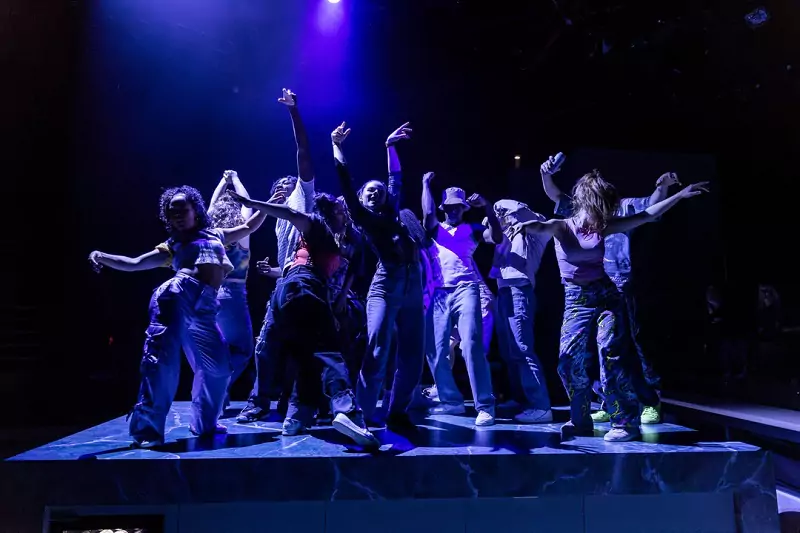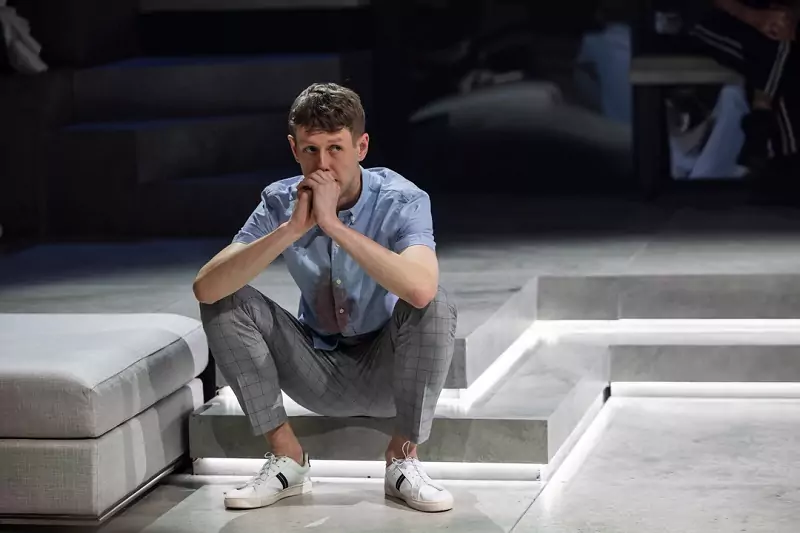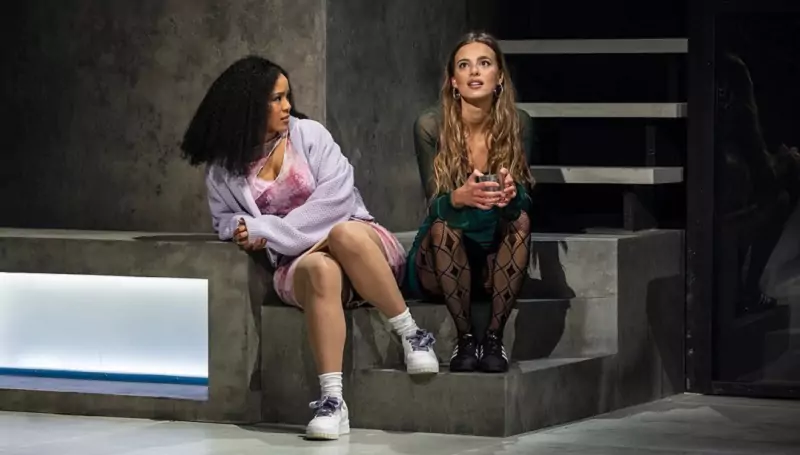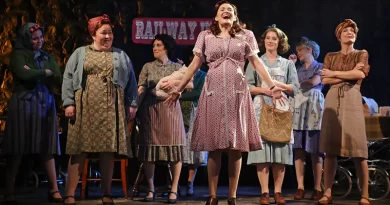“The House Party”, Chichester Festival Theatre
Jeremy Malies in West Sussex
10 May 2024
Strindberg’s 136-year-old play Miss Julie (albeit in a radical workover) proves its enduring relevance here in a co-production by the host theatre, Headlong, and Frantic Assembly. Laura Lomas’s adaptation benefits from a staggering professional stage debut by Nadia Parkes as Julie.

The ensemble.
Photo credit: Ellie Kurttz.
The plot: Julie has turned 18 today and is throwing a party in the modernist mansion of her absent stratospherically wealthy father. Lomas expands the minor role of Christine (a servant in the original) to be Julie’s bestie. By being friends, they have bridged the class divide insofar as Christine’s family used to be servants at the house. Christine is played by Rachelle Diedericks, a Chichester regular.
Christine has a make-or-break interview for a place at Cambridge on the following day. She gets a little drunk of her own volition, a lot drunker at Julie’s behest, and even drunker after Julie, who has been dumped by her boyfriend, attempts suicide. The sequence crushes Christine and we learn in a coda set ten years later that she did not bother to apply for further education of any kind. The message of the postscript (its plot needs to be left under wraps) is how upper-class status often allows people to breeze through their careers while social mobility in the UK is now at a low point after great advances in the sixties.

Josh Finan as Jon.
Photo credit: Ellie Kurttz.
Josh Finan is Jon, Jean as per the original, but younger and without the international travel and work experience of the Strindberg character. If I missed anything from the original, it was his excited talk of opening a restaurant abroad. Jon is also from a family who have worked at the house, and some of the most poignant moments of the evening come when Finan describes his boyhood crush on a girl (Julie) who when she did deign to notice him would deride him for his cheap clothes. Later, he regresses into childhood and starts wiping down the work surfaces of the kitchen in the jerky movements associated with catatonia. It’s acting of the highest order.
Lomas’s writing with its overlapping speech smacks of Caryl Churchill and Polly Stenham – the tone here reminded me of the latter’s That Face – but this isn’t to say that Lomas does not have an original voice and tone. Speaking of Stenham, the adaptation here is even more effective in capturing the zeitgeist of these young people than Stenham’s version at the National in 2018.
New relationships and break-ups appear to be oven-ready for Instagram and TikTok across this young set. A pivot of the action is that Julie has been the victim of a photo (possibly revenge porn) showing her in a compromising situation. It was leaked, and ultimately went viral. Parkes is affecting as she has her character bemoan the fact that this spiralled such that she had to change school and was still hounded. Lomas mainlines us with social media references. If there is anything missing from this wonderful production, it is depiction of these digital feeding frenzies which could have been achieved easily with some slick projection.
The quality of the writing means that the actors (notably Parkes) never need to telegraph meaning with gestures; the dialogue allows them to fuse their physical work with the arc of the speeches. Lomas also appeals to me in that she spears the pretensions and shallowness of these Gen Z hedonists. We watch them charge around to Beyoncé, take endless selfies, and make their flamboyant peace signs. But Lomas is empathetic and never plain cruel. And while there is one huge betrayal, the plot shows many acts of kindness and solidarity between the youngsters.
The supporting cast of party revellers bedecked in Burberry create wonderful rave scenes (movement by Scott Graham) and hint at the earlier drug-taking that has made them so high using individualized actions which underline the care that Race Roughan has lavished on each of them. (Josh uses the word “tripping”.) The dance is intricate but each phase stems from the simplest of initial movements in a style that is now a hallmark of Frantic Assembly. Occasionally the guests pose stock-still as a group like a frieze. Lighting designer Joshua Pharo throws rainbow laser beams at them in these moments.
Lomas makes her characters unusually aware of light; they tell each other about the light in scenes they are remembering and Pharo reinforces this with his design. Most notable is an effect whereby Julie resembles a paper cut-out during her suicide attempt in the bathtub. We feel involved in the grisly action but there is an adept distancing effect. Physicality was one of the main impressions I came away with here.
All the characters narrate their dreams which might sound stylized but proves revealing and economical in terms of exposition. Blood-spatter, the killing of an animal, and references to the Crucifixion could all become clunky. But Race Roughan draws us into this hedonistic horror show. The sex is portrayed well; Finan and Parkes grapple in a stylized (typically Headlong) way while dripping chemistry. Lomas maintains an undertone of sexual interest between the characters throughout without any crudity or the theme being forced.
For this production, the Minerva’s thrust stage has a regular seating area, onstage seating, and immersive tickets for which audience members sit among the partygoers. With the house lights half up, the spectators who were thrown into the mix seemed a tad ill at ease. The main actors and supporting cast use every inch of a set by Loren Elstein which is all clean geometrical shapes from a rectangular kitchen island to the sinuous stalk of an enormous lamp. A gargantuan American-style fridge housing Julie’s stock of white wine sat over my right shoulder.
I never quite understood the geographical setting. It may be a super-affluent suburb of Liverpool or even Finan’s native Wirral nearby. But description of land that sounded like the Fens and Christine’s Cambridge interview also hinted at East Anglia.
If you were being clinical in your judgements, the short final scene after the interval in which we flash forward a decade could be dismissed as lightweight, But for me, a few bars of organ music from Giles Thomas while Diedericks is sitting on the metre of what has now become a prose poem by Lomas proved seductive. I felt I had been gathered in by all this, feeding off the energy in front of me, and becoming slightly trippy myself. Let’s hope that wider audiences might see this outstanding production in a West End transfer.









